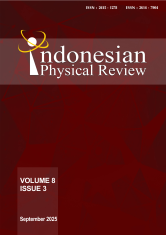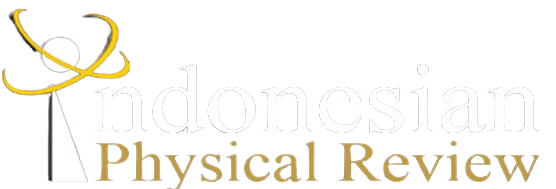ASSESSING CISANTI LAKE SEDIMENTS AS ENVIRONMENTAL QUALITY INDICATORS IN THE UPSTREAM OF THE CITARUM RIVER
DOI:
10.29303/ipr.v8i3.490Downloads
Abstract
Environmental conditions in aquatic ecosystems could change due to the entry of additional materials, such as heavy metals and magnetic minerals. These materials, referred to as anthropogenic materials, could be derived from human activities. The presence of the materials could affect the magnetic properties and heavy metals content of river water and sediments. We have analyzed magnetic susceptibility and heavy metal concentration in sediments collected from Cisanti Lake. Cisanti Lake is known as “zero kilometers†of the Citarum River. Using the level of heavy metals in sediments, we calculated and evaluated pollution indices in the form of Contamination Factor (CF), Geoaccumulation Index (Igeo), and Pollution Load Index (PLI). The results showed that the magnetic susceptibility of sediments (ðœ’ð¿ð¹) was in the range of 317.2 - 2274.9 (× 10-8) m3kg-1, inferring the dominance of ferrimagnetic minerals in sediments. Based on bivariate analysis of ðœ’ð¿ð¹ and the calculated frequency-dependent magnetic susceptibility or cFD (%), domain states of magnetic minerals are clustered at stable single domain (SSD)/multidomain (MD). Pollution indices of CF and Igeo showed that all sample points were contaminated by Cu at a considerable level. Moderate to significant contamination occurred in the studied area according to the PLI analysis. The positive strong correlation between ðœ’ð¿ð¹ and PLI suggests that magnetic susceptibility serves as a proxy indicator of contamination.ÂKeywords:
Cisanti Lake, magnetic susceptibility, heavy metals, pollution indicesReferences
. M.A.E. Chaparro, N. Krishnamoorthy, M.A.E. Chaparro, K.L. Lecomte, S. Mullainathan, R. Mehra and A.M. Sinito, “Magnetic, chemical and radionuclide studies of river sediments and their variation with different physiographic regions of Bharathapuzha River, southwestern India,†Studia Geophysica Geodaetica, vol 59, pp.438-460, Mar 2015, doi: 10.1007/s11200-014-0145-6.
. B. Legowo, S. Putra, H. Purwanto, H. Rifai, W. Suryanto and B. Purnama, “Magnetic Properties of Ancient Sediments Bengawan Solo, Central Java-East Java, Indonesia,†Trends Sci, vol 20 no 5, pp. 6626, Mar 2023, doi: 10.48048/tis.2023.6626.
. D. Fitriani, W. Utami, K.H. Kirana, E. Agustine and S. Zulaikah, “Magnetic sigantures on river sediments and agricultural soils as proxy indicators of anthropogenic-derived pollution (Case Study: Cikijing River, Rancaekek, West Java),†JPPIPA, vol 7 no 3, pp.381-387, Jul 2021, doi: 10.29303/jppipa.v7i3.697.
. M. Maryanto, M.F. Amir, W. Utama, A.H. Hamdan, S. Bijaksana, A. Pratama, R. Yunginger and S. Sudarningsih, “Heavy metal contents and magnetic properties of surface sediments in volcanic and tropical environment from Brantas River, Jawa Timur Province, Indonesia,†Sci. Total Environ, vol. 675, pp.632-641, Apr 2019, doi: 0.1016/j.scitotenv.2019.04.244.
. K.H. Kirana, D. Fitriani, E. Supriyana and E. Agustine, “Sifat magnetik sedimen Sungai sebagai indicator pencemaran (Studi kasus: Sungai Citarum, Kabupaten Karawang),†Jurnal Spektra, vol 15 no 2, pp. 40-42, Dec 2014.
. L.S. Wang. S.Y. Hu, M.M. Ma, X. Wang, Q. Wang, Z. Zang and J. Shen Ji, “Responses of magnetic properties to heavy metal pollution recorded by lacustrine sediments from the Lugu Lake, Southwest China,†Environ. Sci. Pollut. Res, vol 25, pp. 26527-26538, Jul 2018, doi: 10.1007/s11356-018-2725-4.
. I.J. Prasetyo, H. Rifai, Syafriani and R. Putra, “Morphological characteristics and elemental composition of magnetic minerals from the volcanic activity of Lake Maninjau sediments,†Trends Sci, vol 19 no 8, pp. 3428, Jun 2022, doi: 10.48048/tis.2022.3428.
. D. Mejia-Echeverry, M.A.E. Chaparro, J.F. Duque-Trujillo and J.D. Restrepo, “An environmental magnetism approach to assess impacts of land-derived sediment disturbances on coral reef ecosystems (Cartagena, Colombia),†Mar. Pollut. Bull, vol 131, pp. 441-452, Jun 2018. [Online]. Available: https://ri.conicet.gov.ar/bitstream/handle/11336/88342/CONICET_Digital_Nro.a091ca55-5392-4208-9682-672644e08321_A.pdf;jsessionid=7A1164F3E516965746A467413D332386?sequence=2
. J.B. Kowalska, R. Mazurek and M. Gasiorek, “Pollution indices as useful tools for the comprehensive evaluation of the degree of soil contamination – A review,†Environ. Geochem. Health, vol 40, pp. 2395-2420, Apr 2018, doi: 10.1007/s10653-018-0106-z.
. J.A. Dearing, “Environmental magnetic susceptibility: using the Bartington MS2 System 2nd ed, 1999, pp. 1-43. [Online]. Available: https://gmw.com/wp-content/uploads/2019/03/JDearing-Handbook-OM0409.pdf?srsltid=AfmBOooUODPYuxvtCmsVUX6XlFH4XgWJWQLAS62TRt_PjQkzi8CfsIO0
. M.H Evans and F. Heller, “Environmental magnetism - Principles and application of electromagnetics,†Academic Press, 2003; p 1-299.
. G. Müller, “Schadstoffe in Sedimenten-Sedimente als Schadstoffe. Mitt, österr,†Geol. Ges., vol 79, pp.107–126, Dec 1986. [Online]. Available: https://www.zobodat.at/pdf/MittGeolGes_79_0107-0126.pdf.
. S.A. Onjefu, F. Shaningwa, J. Lusilao, J. Abah, E. Hess and H.M. Kwaambwa, “Assessment of heavy metals pollution in sediment at the Omaruru River basin in Erongo region, Namibia,†Environ. Pollut. Bioavailab, vol 32 no 1, pp.187-193, Nov 2020, doi: 10.1080/26395940.2020.1842251.
. L. Hakanson, “An ecological risk index for aquatic pollution control. A sedimentological approach,†Water Res., vol 14 (8), pp. 975-1001, Jan 1980, doi: 10.1016/0043-1354(80)90143-8.
. D.L. Tomlinson, J.G. Wilson, C.R. Harris and D.W. Jeffrey,†Problems in the assessment of heavy-metal levels in estuaries and the formation of a pollution index,“ Helgoländer Meeresuntersuchungen, 33 (1), pp. 566-575, Mar 1980, doi: 10.1007/BF02414780.
. B.S.M. Kim, J.L.F. Angeli, P.A.L. Ferreira, M.M. de Mahiques and R.C.L. Figueira, “A multivariate approach and sediment quality index evaluation applied to Baixada Santista, Southeastern Brazil,†Mar. Pollut. Bull, vol 143, pp. 72-80, Jun 2019, doi: 10.1016/j.marpolbul.2019.04.040.
. S. Sudarningsih, S. Bijaksana, R. Ramdani, A. Hafidz, A. Pratama, W. Widodo, I. Iskandar, D. Dahrin, S.J. Fajar and N.A. Santoso, “Variations in the concentration of magnetic minerals and heavy metals in suspended sediments from Citarum River and its tributaries, West Java, Indonesia,†Geosciences, vol7 (3), pp.1-13, Aug 2017, doi: 0.3390/geosciences7030066.
. R. Thomson and F. Oldfield, “Environmental magnetism,†Allen and Unwin, 1986; p 1-227
. D.S. Xia, F.H. Chen, J. Bloemendal, X.M. Liu, Y. Yua and L.P. Yang, “Magnetic properties of urban dustfall in Lanzhou, China, and its environmental implication,†Atmos. Environ, vol 42, pp 2198-2207, Mar 2008, doi: 10.1016/j.atmosenv.2007.11.040.
. M.O. Kanu, O.C. Meludu and S.A. Oniku, “Comparative study of top soil magnaetic susceptibility variation based on some human activities,†Geofis. Int., vol 53-4, pp 411-423, Dec 2014, doi: 10.1016/S0016-7169(14)70075-3.
. M.A.E. Chaparro, A.M. Sinito, V. Ramasamy, C. Marinelli, M.A.E. Chaparro, S. Mullainathan and S. Murugesan, “Magnetic measurements and pollutants of sediments from Cauvery and Palaru River, Indiaâ€. Environ.Geol, vol 56, pp. 425-437, Nov 2008, doi: 0.1007/s00254-007-1180-1.
License

This work is licensed under a Creative Commons Attribution-NonCommercial-ShareAlike 4.0 International License.
Authors who publish with Indonesian Physical Review Journal, agree to the following terms:
- Authors retain copyright and grant the journal right of first publication with the work simultaneously licensed under a Creative Commons Attribution-ShareAlike 4.0 International Licence (CC BY SA-4.0). This license allows authors to use all articles, data sets, graphics, and appendices in data mining applications, search engines, web sites, blogs, and other platforms by providing an appropriate reference. The journal allows the author(s) to hold the copyright without restrictions and will retain publishing rights without restrictions.
- Authors are able to enter into separate, additional contractual arrangements for the non-exclusive distribution of the journal's published version of the work (e.g., post it to an institutional repository or publish it in a book), with an acknowledgment of its initial publication in Indonesian Physical Review Journal.
- Authors are permitted and encouraged to post their work online (e.g., in institutional repositories or on their website) prior to and during the submission process, as it can lead to productive exchanges, as well as earlier and greater citation of published work (See The Effect of Open Access).





